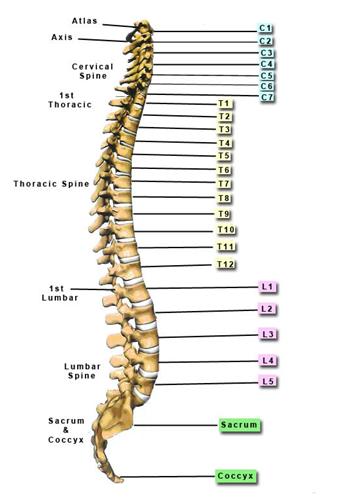
|
Human Spine
Human Spine consists of 33 vertebras, each having different functions. It is broadly
divided in 5 segments/regions.
First 7 vertebras form Cervical region, while next 12 vertebras
form Thoracic region, Next to thoracic region is Lumbar
region which comprises of 5 vertebras
Next region is Pelvic region which is further divided in two regions,
Sacrum (Triangular Bone) & Coccyx (Tailbone).
Sacrum consists of usually five initially unfused vertebrae which begin to fuse
between ages 16–18 and are usually completely fused into a single bone by age 34.
Coccyx comprises 3 to 5 separate or fused vertebrae (the Coccygeal vertebrae). It
is said that Coccyx is the remnant of tail in humans and other tailless primates.
|
It is said that there is nobody in this world who has not experienced back ache
at least once in his/her life time. The above statement might have been exaggerated
but at the same time it is a medical history of mankind that more than 85% of the
people (mostly male) go through little to severe back problem. Back pain is the
second most reason for sick leave after common cough and cold for the people below
the age of 45 years.
The quest is what could be the reason for this? The culprit is Evolution….
Australopithecus which used to exist before 4 million years were biped (two legged)
and their ancestors were quadruped (four legged). During the process of converting
quadruped into biped, the process of natural selection made few changes in structure
of the body for better adaptation of changed lifestyle. Feet, which were used to
grip branches of the tree, had been modified to balance the body. Two legs at front
shrunk to become hands. Fingers got new form to carry out skilled work. To achieve
stable walk, pestle shaped hip bones took the shape of a saucer. As compared to
the 450 cubic centimeter size brain of Australopithecus, Homo Sapiens breed brain
size grew to minimum of 1200 cubic centimeter hence the size of the skull also increased
accordingly. Due to larger size of brain, Homo sapiens also developed thinking abilities
which in effect decreased the need of roaming. While using more & more of their
brain than ever, they developed sedentary lifestyle as compared to other species.
Now let’s check the root cause of problem. When course of evolution transformed
quadruped to biped, it did not make due structural changes in spinal cord. One of
the most important needs was to make the spinal cord more robust. Unfortunately
it did not happen. Added to it load of the head (3 times heavier than before) also
exerted on spinal cord. Maximum load was observed at 3-4 vertebras in lower back
region. That’s how lower back pain became very common in human beings…..
Addendum
An infant's spinal column goes through a variety of changes throughout infancy,
especially in the vertebrae and cartilage. From birth to one month, the spine is
primarily cartilage, with little bones. From one to six months, her spine is changing
shape and reducing in cartilage, and from six months to a year, the spine continues
to change shape, especially the lumbar area, where the spine curves in preparation
for standing and walking.
The primary curve is the name we give to the C-shaped spinal column a baby is born
with. The secondary curves will develop after the first few days of the infant's
life.
The first secondary curve (Cervical Region) to appear allows an infant to support
her own neck. This will develop fully when the infant is several months old. Until
then, parents must take special care to support infant 's neck and head while holding
him and when he's laying in a car seat or stroller.
The lower back is the second secondary curve (Lumbar Region) to develop. It will
continue to strengthen throughout the "creeping and crawling" stage. For this reason,
it is important that parents and caregivers do not rush infant to stand and walk
before he is ready, especially since crawling helps with brain development as well.
Parents should also use caution with carriers or walkers, as these can prompt baby
to stand before he is ready, putting too much strain on the spinal column before
his lower back is more developed.